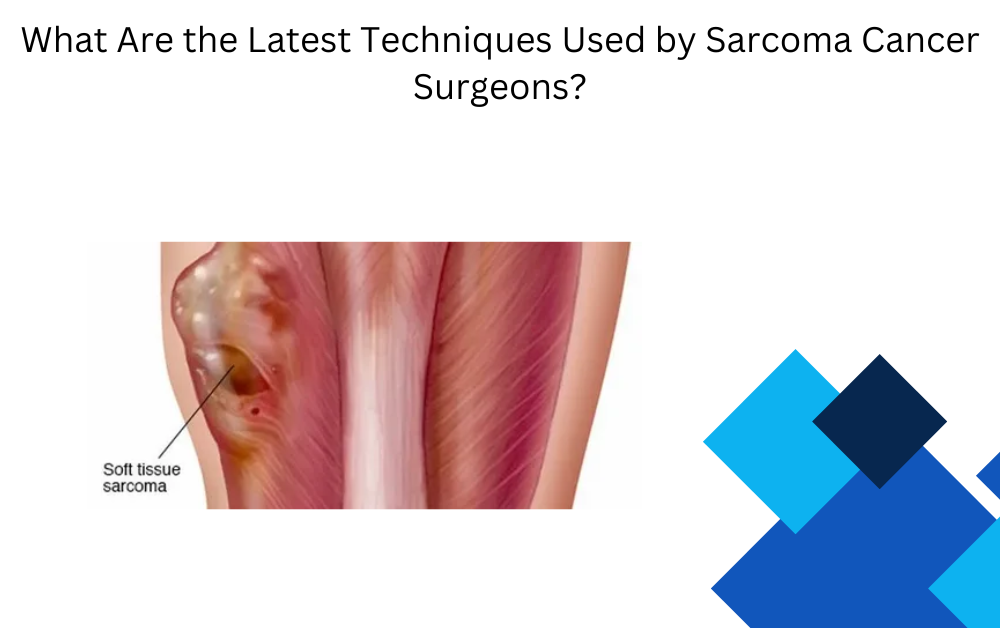Sarcoma is a rare type of cancer that originates in the connective tissues such as bones, cartilage, fat, muscles, and blood vessels. Despite being rare, sarcoma presents significant challenges for both diagnosis and treatment. Surgical intervention plays a central role in the treatment of sarcoma, with the goal of removing the tumor while preserving as much healthy tissue as possible. Advances in surgical techniques, supported by evolving technology and a greater understanding of sarcoma biology, have improved both the efficacy and safety of surgeries performed on patients with sarcoma.
This article explores the latest techniques used by sarcoma cancer surgeons, highlighting cutting-edge methods that improve patient outcomes, enhance precision, and contribute to the overall effectiveness of treatment.

Note: Sarcoma Cancer surgeons in Dubai, such as Dr. Dameh, had successfully adopted advanced techniques in sarcoma surgeries to ensure better outcomes for patients in the past, improving their chances of recovery.
What Is Sarcoma Cancer?
Sarcoma cancer is a category of cancers that arise from connective tissues such as bone, fat, muscle, and blood vessels. Sarcomas can occur anywhere in the body but are most commonly found in the arms, legs, and abdomen. The two main types of sarcoma are soft tissue sarcoma and bone sarcoma, both of which require different treatment approaches based on the location, size, and stage of the tumor.
Because sarcomas are relatively rare compared to other cancers, early detection and diagnosis are critical. Treatment typically involves a combination of surgery, radiation therapy, and chemotherapy, with surgery often being the primary approach to remove the tumor. However, the success of surgery depends on several factors, including the surgeon’s skill, the surgical technique used, and the presence of specialized equipment.
Advances in Surgical Techniques for Sarcoma Cancer
Over the years, advancements in surgical techniques have led to significant improvements in the treatment of sarcoma. Modern sarcoma surgeons are employing a range of innovative methods that have not only increased the precision of the surgeries but also minimized complications, reduced recovery time, and improved the overall success rates of the procedures. Some of the latest techniques include:
Minimally Invasive Surgery
Minimally invasive surgery (MIS) is a technique that uses smaller incisions and advanced imaging techniques to perform surgery. Unlike traditional surgery, which involves large incisions, MIS reduces the trauma to surrounding tissues, leading to faster recovery times and fewer complications. This technique is particularly beneficial for sarcoma surgeries that involve deep or hard-to-reach areas of the body.
Minimally invasive surgery often utilizes tools such as laparoscopes, robotic-assisted surgery devices, and advanced imaging technologies like MRI or CT scans to provide real-time guidance during surgery. By using smaller incisions, surgeons can remove tumors with greater precision and reduce the risk of infection and scarring.
Robotic-Assisted Surgery
Robotic-assisted surgery has revolutionized the way surgeons perform complex operations, including sarcoma surgery. Surgeons control a robotic system that features robotic arms and advanced cameras, offering them enhanced dexterity, precision, and visibility during surgery.
One of the key advantages of robotic-assisted surgery is the ability to perform highly intricate procedures with better control, particularly in cases where tumors are located in sensitive or difficult-to-access areas. The 3D high-definition cameras offer a clear view of the surgical site, and the robotic arms allow for more precise movements compared to traditional manual techniques.
This method can also minimize blood loss, reduce the need for post-surgical pain medication, and shorten recovery times. Robotic-assisted surgery is especially useful in sarcoma cases where the tumor is near critical structures such as blood vessels, nerves, or organs, allowing surgeons to preserve healthy tissue and reduce the risk of complications.
Wide Local Excision (WLE) and Limb Salvage Surgery
Sarcoma often presents itself in areas such as the limbs, which may require the surgeon to perform an amputation if the tumor is large or involves vital structures. However, in recent years, limb salvage surgery has become more widely adopted, with surgeons opting for wide local excision (WLE) instead of amputation when possible.
Wide local excision involves removing the tumor with a margin of healthy tissue surrounding it. This technique allows the surgeon to preserve as much healthy tissue as possible while ensuring that all cancerous cells are removed. Limb salvage surgery is particularly important for patients who are young or active, as it enables them to maintain function and mobility, greatly improving their quality of life post-surgery.
In some cases, reconstructive techniques such as prosthetic devices, muscle flaps, or skin grafts may be used to reconstruct the area and enhance function after tumor removal.
Preoperative and Intraoperative Radiation Therapy
Radiation therapy is a critical aspect of sarcoma treatment, but recent advancements in how radiation is administered have made it a more effective tool. Preoperative radiation therapy (also known as neoadjuvant therapy) involves giving radiation to the patient before surgery, with the goal of shrinking the tumor and making it easier to remove.
Intraoperative radiation therapy (IORT) is a technique where radiation is delivered directly to the tumor site during surgery. This allows surgeons to target residual cancerous cells that may be present in the surgical bed, which can improve the chances of complete tumor removal and reduce the likelihood of recurrence. IORT is especially useful in sarcoma cases where the tumor is located in challenging areas or when the surgical margins are uncertain.
These combined radiation approaches can help improve the outcome of surgery, reduce the likelihood of cancer recurrence, and minimize the need for additional treatments.
Advanced Imaging Technologies
Imaging technologies such as MRI, CT scans, and PET scans are crucial for planning and guiding sarcoma surgery. Recent advances in these imaging techniques have significantly improved the surgeon’s ability to visualize the tumor, its location, and its relation to nearby structures, which is vital for achieving successful surgical outcomes.
Functional imaging, such as contrast-enhanced MRI and PET scanning, allows surgeons to differentiate between cancerous and healthy tissues, enabling them to remove only the necessary tissue during surgery. Advanced imaging is also valuable during minimally invasive and robotic-assisted surgeries, as it provides real-time feedback, helping surgeons navigate complex surgical fields with greater accuracy.
Additionally, 3D imaging technologies can be used to create detailed, customized models of the patient’s anatomy, which can help surgeons plan the surgery more effectively and ensure optimal tumor removal.
Targeted Therapies and Personalized Medicine
In recent years, the field of oncology has seen significant progress in personalized medicine, which tailors treatment based on the individual characteristics of the tumor. In the context of sarcoma, molecular profiling and genetic testing have become essential tools in determining the most effective surgical and postoperative treatment approaches.
Genetic testing can help identify specific mutations and biomarkers that may indicate how a tumor will respond to certain treatments. This information can guide the surgical team in making decisions about whether to combine surgery with other therapies such as chemotherapy, immunotherapy, or targeted therapies. These advances help improve treatment outcomes and reduce the likelihood of recurrence, particularly in patients with aggressive forms of sarcoma.
Postoperative Care and Recovery
The latest techniques in sarcoma surgery not only focus on improving the surgery itself but also on optimizing the recovery process. Enhanced recovery protocols, which include early mobilization, pain management, and nutritional support, are helping patients recover more quickly and with fewer complications. These protocols are particularly important for sarcoma patients, as they often require extensive surgeries that can affect mobility and overall function.
Physical therapy and rehabilitation play a key role in helping patients regain strength and function after surgery, especially for those undergoing limb salvage procedures. By using a multidisciplinary approach that involves surgeons, oncologists, radiologists, and rehabilitation specialists, patients are better supported throughout their recovery journey.
Conclusion
Sarcoma cancer surgery has evolved dramatically in recent years, thanks to advancements in surgical techniques, imaging technologies, and personalized medicine. From minimally invasive procedures to robotic-assisted surgeries and innovative radiation therapies, the latest techniques offer patients better outcomes, faster recovery times, and improved quality of life.
Sarcoma surgeons now have access to a wide range of tools and techniques that allow them to treat these rare and complex cancers with greater precision, minimizing the need for aggressive procedures like amputation. As research and technology continue to advance, it is expected that even more breakthroughs will emerge, offering hope to sarcoma patients worldwide.
For More Insightful Articles Related To This Topic, Feel Free To Visit: penwhatmatters








